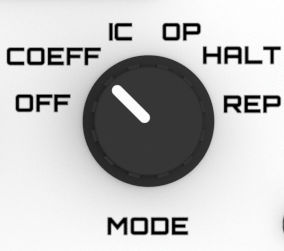Modes
An Analog Computer is operated by switching it into different Modes. This allow control of the time-varying computing elements (the integrators) in the computer, which in turn effect the solution of a patched problem. In The Analog Thing, the modes are chosen by turning an 8-position rotary switch in the lower right of the panel.
The modes of The Analog Thing are as follows.
Minion Mode (MINION)
In this mode, The Analog Thing is remote-controlled by another The Analog Thing. See Daisy Chaining for details of how to use this mode. In case you don't have another Analog Thing, this mode is of no interest for you. It doesn't harm to have your Analog Thing in that mode in case nothing is connected, but don't be fooled it would be turned off -- the Voltmeter is powered off in this mode by intention.
The first position is called MINION and is a remote controlled operation mode where several ANALOG THING devices can be coupled to a bigger analog computer. See the MINION section for more details.
Turned-Off Mode (OFF)
In this mode, The Analog Thing is turned off. Please always remove the Power chord in order to make sure everything is free from electricity if you want to do something crazy with the electronics. Otherwise, it is completely fine to change the program also while the computer is running.
In position OFF the incoming power is switched off electronically with a MOSFET transistor and power consumption is reduced to about 2 mA / 5 V or approx. 10 mW only. This is a safe position to connect or disconnect any cables. In any other mode the device is working with a typical quiescient current of about 300-350 mA / 5 V or 1.5-1.75 W.
Coefficient-Setting Mode (COEF)
This mode is all about fine tuning Coefficients/Potentiometers. See there for how to use this mode.
The COEFF mode is used to setup the coefficients in a system of differential equations, which are describing a specific system or task to be simulated with an analog computer. Up to 8 coefficients are available on the ANALOG THING in the single mode or a multiple of 8 using several ANALOG THING connected together in the MINION mode.
The coefficient 1-8 can be choosen with the coefficient switch and it's current value is shown on the display and can be changed turning the appropriate potentiometer (single-turn). The slower and more carefully the turn, the more accurate the value can be setup. Only positive values from 0.0 – 1.0 are possible. Negative values need an additional inverter or summer. It is helpful to optimize the system of differential equations to reduce neccessary inversions to a minimum.
Initial Conditions Mode (IC)
In this mode, the integrators are charged for their Initial conditions. The yellow IC LED is glowing. This mode is helpful if you manually do a IC/OP cycle.
This is the initial condition of the analog computer. In this position all integrators are cleared and setup with a initial value. Initial values are setup using an unused coefficient except for an initial value of 0 which is the default value.
Operations Mode (OP)
In this mode, the analog computer is in normal operating mode. That means, the integrators are freely integrating. Depending on your application, it can be interesting to have something running for several seconds or even minutes. The green OP LED is glowing. It may occur that you immediately run into some Overflow problem, in this case the red OL LED glows.
The OP is the functional operation mode. Operation can be halted with switching to next HALT position and continued switching back to OP. Toggling between OP and HALT allows the user to measure and investigate the condition of the analog computer inbetween running mode. Switching back to IC will restart the program from the initial state while HALT will only interrupt the operation mode without changing conditions of variables.
Halting Mode (HALT)
In this mode, the analog computer is pausing the integrators. They hold their values and can be readily read off. This is useful for static analysis of the circuit, or for testing values with the Voltmeter. You can go back to Operations Mode at any time.
The HALT mode halts the current operation/program running for investigation of the current program and variables. Operation can be continued with switching back to OP.
Repetitive Mode (REP)
In this mode, the analog computer is automatically and repeatedly switching between IC and OP mode. While the IC time is hard coded to ![]() Fill me in, the OP time can be chosen within a range of minimum
Fill me in, the OP time can be chosen within a range of minimum ![]() Fill me in and maximum
Fill me in and maximum ![]() Fill me in miliseconds with the slider called
Fill me in miliseconds with the slider called OP TIME.
The schematics below shows the realisation of the repeated operation which is a feature to visualize the signals in an Y/T oscilloscope view. There are 2 options available for long operation times (slow mode) from less than 100ms to 10 seconds and a faster mode REPF for operation times of less than 1ms to 100ms.
Fast Repetitive Mode (REPF)
REPF is the mode for faster operation and allows the setup in the range of 1ms to 100ms. In the REPF mode the IC time (initial setup) is reduced to about 1.5ms. This is realized with the analog switches in the time control schematics. The pictures below show the operation times of 10ms and 1ms.
